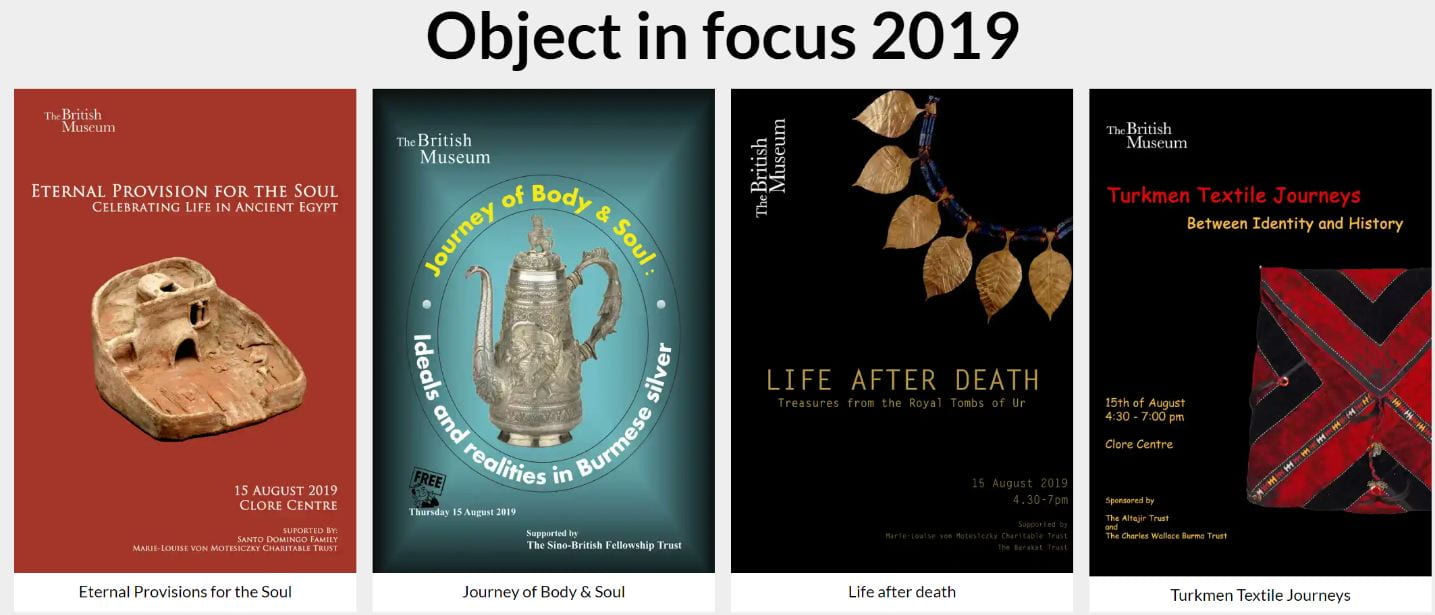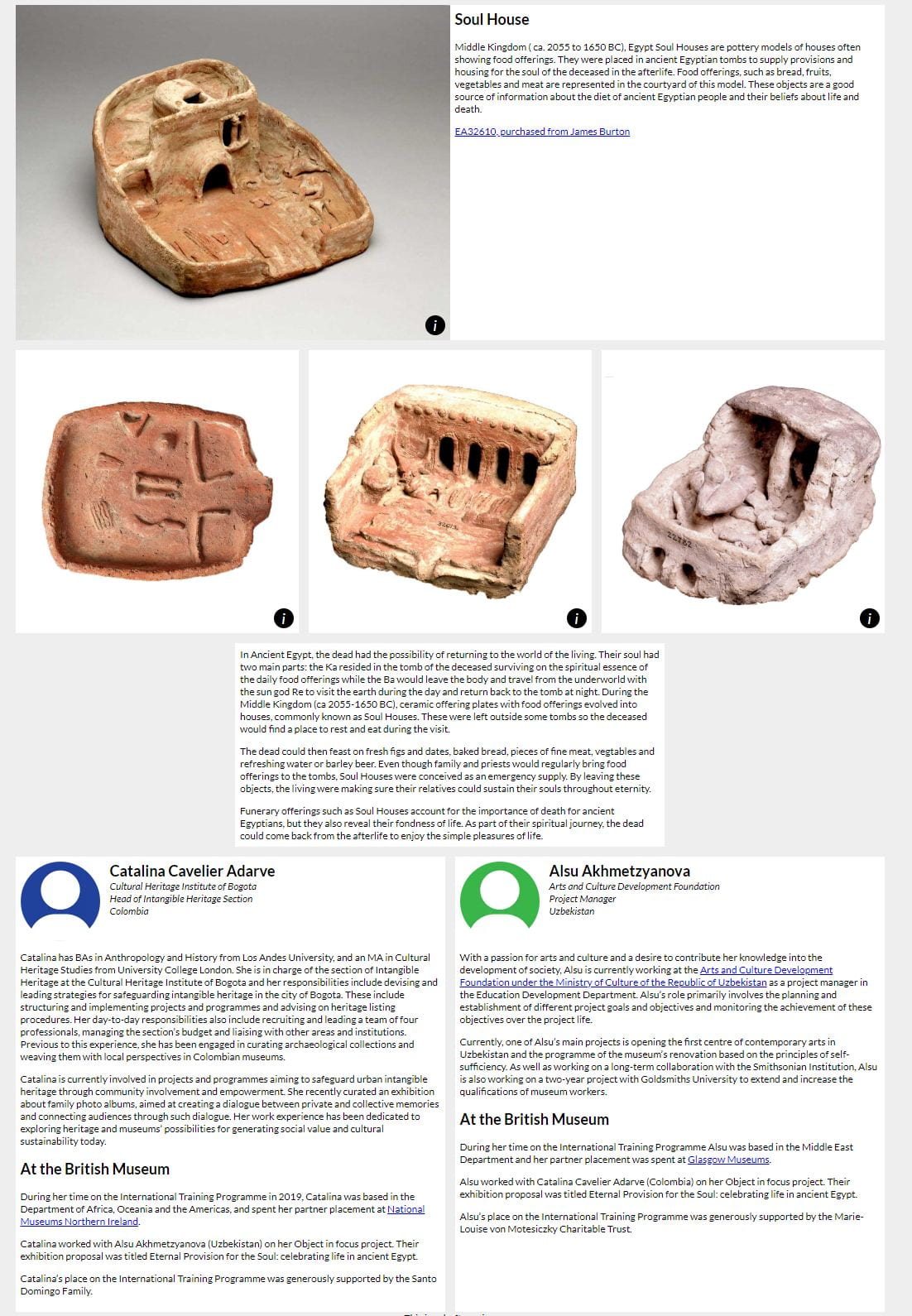Object in Focus Online at the British Museum
| Sponsor: | The British Museum | |
| Sponsor Liaison: | Claire Messenger, George Peckham | |
| Student Team: | Esteban Aranda, Kyle Ehrlich, Kevin Moore, Nicholas Sackos | |
| Abstract: | Since 2006 the British Museum’s International Training Programme (ITP) has developed a global network of 299 museum professionals. The ITP hosts a yearly professional development conference in London. Participating fellows choose an object to create and present an exhibition with a poster, additional images, and an interpretive panel. We developed a website that showcases the exhibitions and serves as a tool to develop the online skills of fellows. We wrote a manual explaining website maintenance and expansion for future exhibits. | |
| Link: | Object in Focus Online Final Report | |
Executive Summary
Online exhibitions are tools that are becoming increasingly common in the museum world. They are used as a way for museums to expand their reach beyond physical constraints. In 2019, the British Museum had 33.6 million online visitors, far greater than the 6 million people that attend the physical museum (The British Museum, 2019). The success of the museum’s online platform has led other groups to capitalize on this new medium. One of these groups is the British Museum’s own International Training Programme (ITP). The ITP program takes advantage of the British Museum’s staff and expertise to train and assist museum staff from around the world that are part of the ITP’s professional network. Naturally, as online resources become more prevalent, one of the goals of the ITP is to help professionals at other museums develop their online skills and content.
The central event of the ITP is a 6-week summer program during which fellows attend workshops and collaborate on training projects. The final part of the event is the ‘Object in focus’ project where fellows are tasked to develop a physical exhibition based on an artifact from the British Museum collection. The finished exhibitions are displayed for the public and British Museum personnel to see during the final days of the conference. Currently, these exhibition materials from the summer conference are kept in internal digital archives at the British Museum. The ITP would like to maintain lasting professional connections that extend past the end of the summer program. To achieve this goal, the ITP wants to make the Objects in focus exhibitions more accessible for museum professionals and the general public. However, there is currently no platform that displays them.
The goal of our project was to create an online exhibition for the British Museum centered around the work of the International Training Programme and their Object in focus exhibits. To achieve this goal, we:
1. Assessed the state of the art in online exhibitions through research and interviews with accredited institutions and staff.
2. Identified the design requirements for the Object in focus exhibition by interviewing the British Museum staff and ITP fellows.
3. Developed the Object in focus exhibition using an iterative approach that gathers and integrates feedback from the ITP fellows and British Museum staff.
The primary deliverable in this project was a website featuring an organized collection of the past ITP collaborative summer capstone exhibitions. The website reflects the vision of the team, the British Museum staff, and the ITP fellows who were interviewed. A second deliverable was the manual (Appendix C) for the British Museum staff which outlines not only how to maintain the website but how to add the materials from future summer sessions to the collection.
The design criteria we established for the website was the culmination of the information gathered from prominent online exhibitions. We wanted the site to be elegant and good-looking at first impression. To do this we used a grid pattern with large images and a distinctive landing page which let the user know they were in the correct place on the website, shown in Figure ES1. This organization permeated through other pages of the website, with areas of dense text being organized into neat boxes which serve as dividers, shown in Figure ES2. Another essential component of the website, ease of navigation, tied in well with making the website look appealing and clean. The large images on the home screen all serve a secondary function as links to the different webpages in the site, making it so clients can just click on what they like and immediately receive more information.
With these criteria in mind, we made several key design decisions throughout the development process. We sorted the projects by year as the audience would likely be sorting the projects by the summer conference they are interested in rather than the country of interest. We had a poster, interpretive panel, additional photos for nearly every exhibition along with bios for each ITP fellow describing their work inside and outside the British Museum. We agreed that this would be useful information to include on each page so that we could build pages with high consistency.
High consistency was also a key aspect of templatizing the creation of content on the website. We intended to make it as easy as possible for future museum professionals to build on the website without necessarily having the technical expertise of our team. We made the website very simple and streamlined, so the structure would be easily comprehensible. We also developed a concise and descriptive manual for adding content to the site, which was tested by team members with lower technical proficiency and proved to be extremely simple to use.
We recommend that the British Museum’s ITP follow the manual in Appendix C to maintain the website, add content from previous exhibitions and future Object in focus projects, and implement desired features that we did not have time to include. Secondly, as staff members expand the site and add new features, they should solicit feedback from fellows and other staff members on functionality, navigability, content, and aesthetics. We also recommend a software toolkit for the ITP staff to use to edit the content files and built utility scripts to help with file conversion. We recommend that, going forward, fellows develop their projects around a standardized template so that they can be added to the website with ease. Finally, new profile pictures for the fellows, should be taken and uploaded to replace the placeholders in the website. Overall, this website will give the ITP Object in focus exhibition a higher profile in the museum professional space. Further, the website will be used as a tool to provide new training opportunities for less technically proficient ITP fellows.




